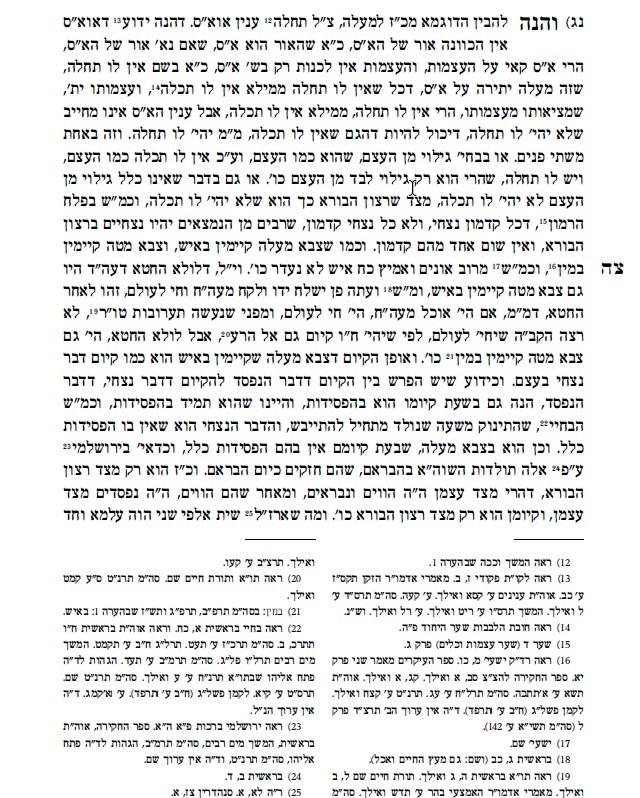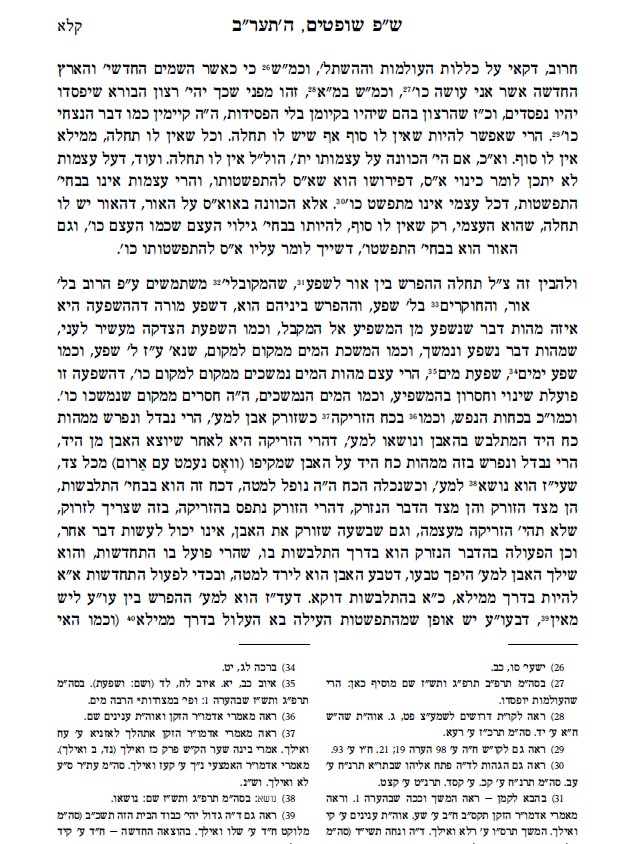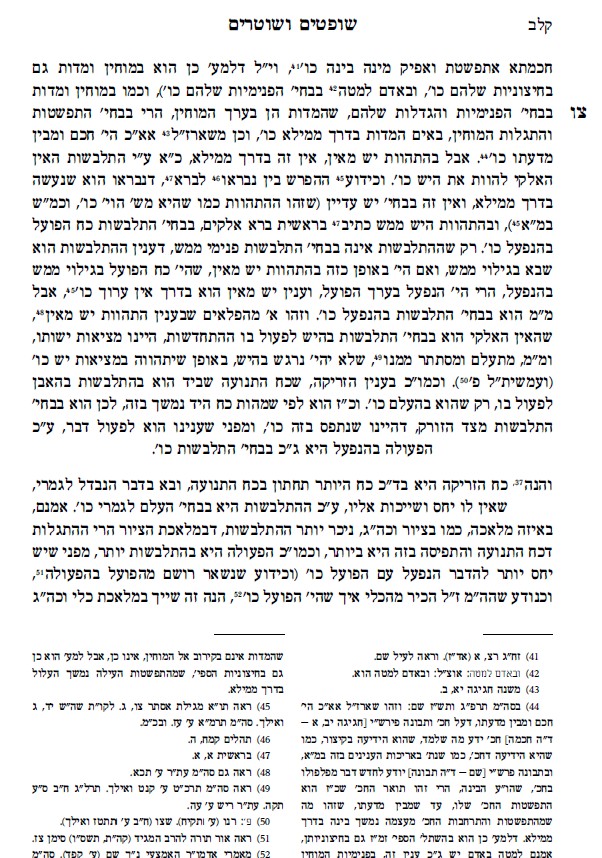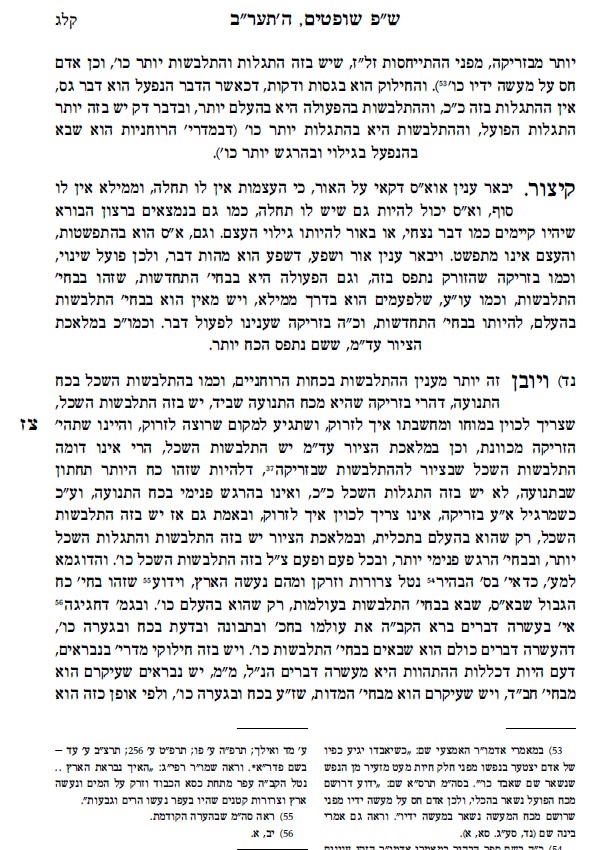AYIN BEIS | Existence Unplugged
Chapter 53: Infinite Light – Shefa and Ohr (part 1)
Short Summary
Ohr ein sof means that the energy itself is infinite. We can understand this by examining the difference between shefa (flow) and ohr (light), with shefa being an emission of substance that creates a change and effects its source, and requires investment.
Long Summary
[To understand the difference between the transcendent energy (sovev, makif) and the immanent energy (memaleh, pnimi), he now begins a new discussion on the nature of “ohr ein sof, the infinite light, and the difference between two types of emission — ohr (energy/light) and shefa (flow), with the former just reflecting its source and the latter impacting and being internalized in the containers, which will explain the difference between transcendent energy that has no function other than revealing its source, and immanent energy, whose function is to serve existence and be internalized].
To understand the example of all this [desire and faculties, transcendent and immanent energy] above, we need to first explain the concept of ohr ein sof — “infinite energy/light” Ohr ein sof does not mean energy of the infinite (“ein sof”), but infinite energy, that the ohr itself is ein sof, for two reasons:
1) We cannot attribute the title “ein sof” (without end) to the Essential Source, because if we are to apply any title to Him it would have to be “ein techilah” (without beginning), which is far more appropriate being that this describes the exclusivity of the Source, whose existence comes from within itself (metziyuso m’atzmuso), has no cause and no beginning, and thus has no end. But there are other entities that have no end, though they have a cause and a beginning, for one of two reasons: a) it reflects the infinity of the Source. b) G-d infused the entity with an eternal power, that as long as it exists, it is eternal, perpetual (the celestial bodies perpetuate individually; earthly creatures perpetuate as a species).
2) “Without end” implies expansion — something that spreads endlessly. We cannot apply the concept pf expansion to the Essence, which does not expand.
We must therefore conclude that “ein sof” in “ohr ein sof” is not referring to the source of the energy, but to the energy itself. It is not energy of the infinite ein sof, but that the energy itself, which has a beginning and a source, has no end.
To understand this let us first examine the difference between “ohr” and “shefa”: The Kabbalists primarily use the term “ohr” — light/energy — to express divine emission, while the philosophers use the term “shefa” — flow.
Shefa refers to a emission of something that has substance, like charity or the flow of water (shefa yamim), in which something material is being emitted from transmitter to recipient, effecting a change in the transmitter. Similarly, the human faculties impart a flow of energy into the object they are impacting. When one throws a stone, for example, the arm imparts its energy into the stone, in a way in which the energy is now separate and apart from its source (the arm) and is manifest in the stone, causing it to be carried until the energy in it subsides. This emission is immanent and manifest in nature (hislabshus), both from the perspective of the source and the object: The thrower has to invest himself in the act and he cannot do something else simultaneously with that energy; the stone is impacted by the energy causing it to (temporarily) defy its nature and fly. [This is the difference between a form of cause and effect (ileh v’olul), in which the effect automatically results from the cause, and creation of “something from nothing” (yesh m’ayin), which requires that the divine power manifest in the creation process (albeit in a concealed form)].
The power of throwing an object is in general the “lowest” (most menial) expression of the human faculty of movement, expressed in a an act that is outside of the person (not reflecting the personality of the individual). The energy is therefore concealed within the act [similarly above, the power of creation is concealed from the creature]. By contrast, any craft, like the skill of drawing, the energy is more apparent, because the artist manifests more of his energy in his art, and the art reflects more of his persona, i.e. there is a closer relationship between between the production and the producer (which is why the Maggid was able to recognize in a vessel the crafter’s nature). The difference in the relationship between the producer and the product or activity is defined by the activity’s quality: In a coarser activity (like throwing) the source and energy are less revealed and manifest. In a subtler and more refined activity the source and energy are more revealed and manifest (spiritually this means that the energy is felt stronger).
Hebrew Text




Concepts
Ohr Ein Sof, Infinite Light. Shefa.
Sources
THE EVOLUTION OF THE CONCEPT OF OHR AND SHEFA
The ideas discussed in these chapters (53-56), namely the level of ohr ein sof, and its explanation derived from understanding the reason for using the name ohr and not shefa, are based on several discourses of the Alter Rebbe, as elucidated by the Tzemech Tzedek. Listed below are these sources, indicating the nuances emphasized in each respective discourse.
Ohr Ein Sof, Ein Techila (first half of ch. 53): The question why ohr is called ain sof and not ain techilah and the explanation that it is referring not to Atzmus (which is ein techilah, and cannot be defined by an infinite extension), but to a level that is not atzmus — is from the Rameh (Menachem Ezaryeh) M’Pano in Pelach HaRimon gate 4 ch. 3 and in his introduction to Yonas Ilam (cited in the Tzemech Tzedek’s gloss to Likkutei Torah Pekudei 7b. And in more detail in his Biurei HaZohar vol. 2 p. 1011). However there he explains that ein sof is the level of desire (ratzon, keser). This is rejected by the Alter Rebbe, with the argument that desire is a defined state and we therefore cannot attribute ein sof to it. Instead he explains that ein sof refers to ohr (the ohr itself is ein sof, and not just ohr of ein sof) — L’hovin Inyan Ohr Ain Sof of Shabbat Parshat Shemos 5567 (Maamorei Admur HaZakon 5567 p. 22. Inyanim p. 52. With additions — Ohr HaTorah Inyanim p. 181 (printed also in 5567 p. 423)). As elaborated in the Tzemech Tzedek’s explanation of this discourse there pp. 175 (see also there p. 141), and at length in Vayeilech, Zos Chukas and Ki Imcho Samach Vav. See Likkutei Torah Shir Hashirim the second biur to the second Shechoreh Ani (8a-b) (cited here in ch. 27). This idea (that ohr is higher than desire) is cited and explained later here in Ayin Beis chapters 56-57; 69.
The two reasons given here explaining why we cannot say ein sof on Atzmus (because a more appropriate description is ein techilah, and we cannot apply an extension of “no end” to an essence which does not extend) is taken from the Sukkos 5563 discourse (version 1). the second reason is also in 5567.
The ensuing discussion here about shefa and ohr (in the second half of ch. 53), and the two examples of sunlight and the soul (ch. 55-56) is based on:
1. The continuing discussion in the abovementioned: a) 5567 discourse, which explains why the ohr itself is ein sof based on the reason for using the name ohr (he does not mention shefa there); and b) Sukkos 5563 discourse, which specifically discusses the difference between ohr and shefa, as well as on the following discourses of the Alter Rebbe, with different nuances in each respective discourse as indicated below:
2. Bereishis 5562 p. 42. With the Tzemech Tzedek’s additions: Vol. 2 p. 584; Ohr HaTorah Inyanim p. 342; Bamidbar (Massei) p. 1451: Ohr and shefa. Example of sunlight. He cites there (and also in #3 below p. 155) Kol Dodi in Likkutei Torah (13b) and L’hovin Inyan Ohr Ain Sof (5567?), where he explains that the divine transmission is like sunlight which has no impact on its source.
3. L’hovin Inyan Ohr Ein Sof, Beis, Parshas Acharei (after Pesach) 5563: Maamorei Admur HaZakon 5563 p. 335 (two versions). The Tzemech Tzedek’s hanocho of the discourse — ibid p. 411. Ohr HaTorah Inyonim p. 155. Also printed in Sefer HaMaaorim 5627 (of the Rebbe MaHarash) p. 421. V’kocho 5637 ch. 99 (only the examples for ohr in ch. 55). Other versions from the Tzemech Tzedek — Ohr HaTorah ibid p. 147. 158. Vaeira p. 2576. In the above places he cites all three examples (sunlight, soul, fire) to explain the why we call it ohr and not shefa and he brings a second reason given for this (in addition to the one cited here, that ohr does not impact its source) — that it signifies revelation of the concealed (gilui ha’helem), rather than extension from the source (hispashtus). See also Vayishlach 5562 p. 80 (cited ibid p. 160). In his addition the Tzemech Tzedek (p. 147-148) qualifies both examples, which is the basis of chapter 56, that the soul is bound to the body and the sun must shine. Thus these examples complement each other.
4. L’hovin Inyan Ohr Ein Sof She’hu L’maaleh Ad Ein Ketz, Around Pesach 5562 – Maamorei Admur HaZakon 5562 p. 370. Acharei 5563 – Ohr HaTorah Inyanim p. 110. 126. 143. Beshalach pp. 411: Lengthy discussion on the difference between ohr and shefa, utilizing the example of throwing an object, the manifestation of the faculties, the difference between throwing and drawing (OT p. 118), as explained here (ch. 53-54). The Tsemech Tzedek (Inyanim p. 126-129) also discusses shefa in context of the immanent energy (the ten sefirot) as expressed in human faculties, which is the elaborate theme discussed here (beginning from chapter 2), in contrast to ohr which is transcendent energy (above the sefirot) and does not manuifest (it contains everything but nothing contains it), unlike the soul that manifests in the body (Inyanim pp. 130. Beshalach pp. 411). Indeed, even the immanent divine energy from the perspective above remains transcendent and is not contained by the containers, which explains how the energies can exchange roles (see ch. ). However, the Tzemech Tzedek explains this according to the opinion that the energy has no form (like colorless liquid in tinted glasses). While here he explains it even according to the opinion that the energy does have form.
5. L’Hovin Inyan Tzimtzum, 1st night of Sukkos 5563. We have two different versions of this discourse, with a key distinction between them: The first version is printed in Maamorei Admur HaZakon 5563 vol. 1 p. 279 (he connects there ohr ein sof and not ein lo techila with the explanation of the difference between ohr and shefa). The second version is in Vol. 2 p. 550. Ohr HaTorah Sukkos p. 1736. See there p. 1733-1735.
In the first version (as underscored by the Tzemech Tzedek ibid p. 1736) he negates, right from the outset, the example of the sun due to the light being of the same substance as the sun itself (which can perhaps be related to the qualification of this example here in ch. 56, especially according to the Tzemech Tzedek’s explanation that the entire purpose of the sun is to illuminate. Based on this perhaps we can say that this is referring to the essence of the light discussed later in ch. 57, which has no function other than revealing its source, unlike the sun which has a function as discussed in ch. 48. However, regarding the extension of the light which has a function, the sun is a fitting example), and instead opts primarily for the example of the soul’s life force (as well as the glow of a brilliant stone). Another reason for negating the example of sunlight (though it is useful in understanding how creation is not in as form of cause and effect, like shefa) is due to sunlight being impacted by an impediment causing it not to extend as far as it would without the impediment (which actually appears to contradict what it says here in ch. 55 that an impediment has no impact at all on the sun and on its light. Perhaps this can be reconciled based on the earlier comment that distinguished between the essence and the extension of the energy: the essence of the energy cannot be in any way impacted by any tzimtzum; which the extended energy can be). The more fitting example for divine energy (ohr) is the soul’s life energy, which does not extend from its source (hispashtus), bur only reveals that which is concealed (gilui ha’helem). See also the Acharei 5563 discourse cited below.
In Ohr HaTorah ibid p. 1734, he elaborates on the example of the soul’s life force (citing incidentally recincarnation to demonstrate that the essence of the soul does not manifest in the body. This is also cited in Vayishlach 5562, see #2), and then qualifies it since the soul is bound by the body, unlike the divine energy — as discussed here in ch. 56. In the second version of this discourse he brings both examples of the sun and the soul (as well as the example of the flame that heats metal cited here in ch. 55), without qualifying them. Compare this with L’hovin Mah She’Kosuv b’Etz Chaim de’Bechinas HaKav V’chut, First night of Sukkos 5568 (Inyanim p. 366).
This discourse also connects this idea with the level of a “name,” which is only a reflection that does impact the source. This theme is discussed later ch. 305 and on. See Kol Dodi in Likkutei Torah.
Note p. 281: The difference between ohr and atzilus: ohr is revelation alone; atzilus is the revelation that is diminshed (be’tzimtzum).
6. 1st night of Sukkos 5568 – Maamorei Admur HaZakon Inyanim p. 336.
7. Maamorei Admur HaZakon 5568 p. 319; 5570 p. 44.
See also: Torah Ohr Vayikra 87a: Reason for the name ohr due to it only bring a reflection leaving no impact on its source. Maamorei Admur HaZakon Inyanim pages: 100. 319. 327. 336. 357. Imrei Binah ch. 13. Sefer HaMitzvos He’monas Elokus ch. 5 (50b). 152b.

 Anchor
Anchor Breaker
Breaker Google Podcasts
Google Podcasts RadioPublic
RadioPublic Spotify
Spotify Pocket Casts
Pocket Casts